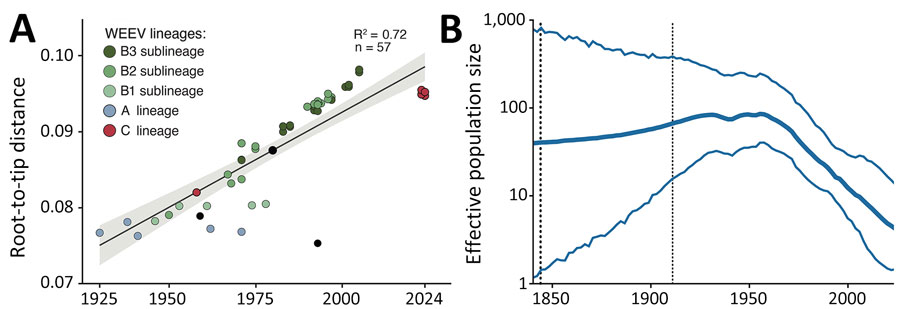Molecular Epidemiology of Western Equine Encephalitis Virus, South America, 2023–2024
Aline Scarpellini Campos, Ana Claúdia Franco, Fernanda M. Godinho, Rosana Huff, Darlan S. Candido, Jader da Cruz Cardoso, Xinyi Hua, Ingra M. Claro, Paola Morais, Carolina Franceschina, Thales de Lima Bermann, Franciellen Machado dos Santos, Milena Bauermann, Tainá Machado Selayaran, Amanda Pellenz Ruivo, Cristiane Santin, Juciane Bonella, Carla Rodenbusch, José Carlos Ferreira, Scott C. Weaver, Vilar Ricardo Gewehr, Gabriel Luz Wallau, William M. de Souza
1
, and Richard Steiner Salvato
1
Author affiliations: Secretaria de Saúde do Estado do Rio Grande do Sul, Porto Alegre, Brazil (A.S. Campos, F.M. Godinho, R. Huff, J. da Cruz Cardoso, P. Morais, C. Franceschina, F. Machado dos Santos, M. Bauermann, T.M. Selayaran, A.P. Ruivo, R.S. Salvato); Universidade Federal do Rio Grande do Sul, Porto Alegre (A.C. Franco, T. de L. Bermann, R.S. Salvato); Imperial College London, London, UK (D.S. Candido); University of Kentucky, Lexington, Kentucky, USA (X. Hua, I.M. Claro, W.M. de Souza); Secretaria de Agricultura do Estado do Rio Grande do Sul, Porto Alegre (C. Santin, J. Bonella, C. Rodenbusch, J.C. Ferreira, V.R. Gewehr); University of Texas Medical Branch, Galveston, Texas, USA (S.C. Weaver); Fundação Oswaldo Cruz, Recife, Brazil (G.L. Wallau); Bernhard Nocht Institute for Tropical Medicine, Hamburg, Germany (G.L. Wallau)
Main Article
Figure 3

Figure 3. Phylogenetic analysis of WEEV strains from Rio Grande do Sul state, Brazil, and reference sequences. A) Regression of sequence sampling dates against root-to-tip genetic distances in a maximum likelihood phylogeny of the WEEV strains. Sequences are colored according to geographic source. Line indicates the correlation; shading indicates 95% CIs. B) Effective population size of WEEV through time using the Skygrid model. Thin blue lines represent 95% Bayesian credibility interval, and the thick blue line represents the posterior median. Vertical dotted lines indicate the best estimates for the time of the root of the tree (left) and the upper highest posterior density (right). WEEV, western equine encephalitis virus.
Main Article
Page created: July 25, 2024
Page updated: August 22, 2024
Page reviewed: August 22, 2024
The conclusions, findings, and opinions expressed by authors contributing to this journal do not necessarily reflect the official position of the U.S. Department of Health and Human Services, the Public Health Service, the Centers for Disease Control and Prevention, or the authors' affiliated institutions. Use of trade names is for identification only and does not imply endorsement by any of the groups named above.
